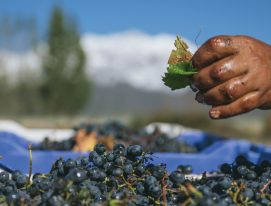With over 182,000 hectares planted across the world, Garnacha has for years been a star grape across the different regions of Spain and France. From sparky rosés to robust, concentrated reds, its versatility and character have made this grape a favorite among winemakers, sommeliers and consumers. Now, in Argentina, Garnacha is beginning to write a new and exciting story. Argentina has 55.9 hectares of Garnacha under vine, of which 54.6 are reds and 1.4 are whites according to a recent report by the National Institute of Viticulture. The variety is forging new paths in Argentine viticulture and arousing the curiosity of drinkers looking for fresh, innovative wines with a profound connection to the terroir.
The resurgence of Garnacha in Argentina

Although Garnacha has a limited presence in Argentina, it has made a major impact. In recent years, the grape has found a new home in regions such as the Uco Valley, Calingasta, the Calchaquí Valleys and the Quebrada de Humahuaca, where the stony soils, intense sun and cold nights create the perfect conditions for it to thrive. The Mediterranean grape, known for its resistance to drought and ability to adapt to warm climates, has made it ideal for high altitude vineyards and the more arid areas of the country. The most is grown in the Province of Mendoza, followed by La Rioja, Salta, San Juan, La Pampa and Jujuy.
Andrés Biscaisaque at Finca Los Dragones in Calingasta, San Juan, started to plant Garnacha in 2019 in search of a fresh, light wine but with the ability to express the complexity of the terroir. “The intense sun, rocky soils and cold nights suggested that Garnacha would go perfectly in the region. Its tolerance of drought and vigor make it a solid bet in a heating world,” says Andrés.
Innovation and diversity in the vineyards
One of the main attractions of Garnacha in Argentina is that it brings greater diversity to wineries’ portfolios. At Solocontigo Wines, in Los Chacayes, Mariela Ilardo explains: “We opted for Garnacha because we were looking for something disruptive and innovative. Los Chacayes has ideal conditions for the variety and we knew that we could compete with other specialized regions. The public response has exceeded our expectations.”
Marina Onofri, at Alma Gemela, remembers: “We began with Garnacha in 2016 when there were very few vineyards with the grape left in the country. It was exciting to see the variety adapt so well to the terroirs of Lavalle and the Uco Valley. The fresh, fruity wines have been very well received and today we’re exporting it to the UK, something we’d never have imagined.”
A tour of Garnachas

Investigating Argentine Garnachas means taking a trip across different topographies and styles, although most wineries are using it to produce light, fresh and fruity wines.
In the Calchaquí Valleys, Estancia Los Cardones produce their Tigerstone Garnacha in Tolombón, while in Cafayate, Porvenir de los Andes makes a Pequeñas Fermentaciones and El Esteco has limited edition Garnacha from the La Turbina vineyard. In Barreal, San Juan, Finca Los Dragones make their vibrant Los Dragones Garnacha from parcels in El Pedrazal.
In Mendoza, Alma Gemela make their Garnacha with grapes from Lavalle, while in Maipú, D.V. Catena Garnacha apelación Lunlunta demonstrates its potential in the Primera Zona. In the Uco Valley, meanwhile, Los Chacayes is the epicenter of Argentine Garnacha. The varietals made by Corazón del Sol, Martino, Ver Sacrum and SoloContigo Neelands Row Selection highlight the adaptability of the grape at altitude and in the extreme climate found in the region. Tupungato, in the north of the Uco Valley, also has a few, such as Ruca Malen Capítulo Dos and Desquiciado Salvaje.
A Brilliant Future
Although Garnacha is still quite scarce in Argentina, it has unquestionable potential. The fresh, expressive and vibrant wines it’s producing haven’t just caught the attention of the local market, they’re beginning to make waves overseas. As Marina Onofri notes, “Consumers looking for lighter, elegant wines have a perfect option in Garnacha.”
This grape, which has been a part of European viticulture for centuries, is starting to make a name for itself in Argentina. With more being planted and wineries increasingly appreciating its versatility, Garnacha will continue to win fans in Argentina and overseas.



